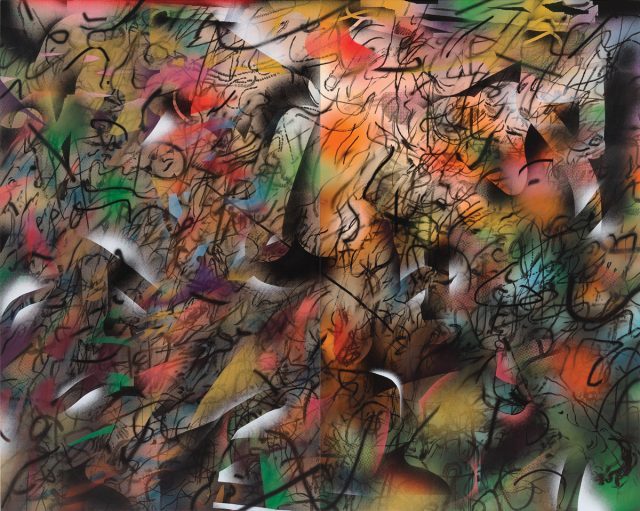
Julie Mehretu, Ghosthymn (after the Raft), ink and acrylic on canvas, 2019–21 (photo by Tom Powel Imaging / © Julie Mehretu / courtesy Marian Goodman Gallery)
JULIE MEHRETU
Whitney Museum of American Art
99 Gansevoort St.
Exhibit continues Thursday – Monday through August 8, $18-$25
Palimpsest: Thursday, June 17, free with RSVP, 8:00 (available on demand June 18-20)
Pride Celebration with Julie Mehretu: Friday, June 25, free with RSVP, 7:00
212-570-3600
whitney.org
Over the years, I’ve seen many works by Julie Mehretu, but her eponymously titled midcareer retrospective at the Whitney is still a revelation. Running through August 8, the show consists of approximately thirty paintings and forty works on paper and prints from 1996 to the present by the Ethiopian-born artist, who moved with her family to Michigan when she was seven in 1977 and is now based in Harlem. Her large canvases are palimpsests of architectural urban maps, news clippings, allegorical references, economic charts, art history, and abstract lines and shapes, coming together to form a tantalizing whole that is both visually dazzling and empowered with meaning. “Mehretu analyzes and reimagines divergent cultural narratives through her own artistic methodology; an extraordinary thinker and observer, she produces work that is full of empathy, innovation, complexity, and contradiction,” LACMA CEO and director Michael Govan writes in the forward to the catalog.
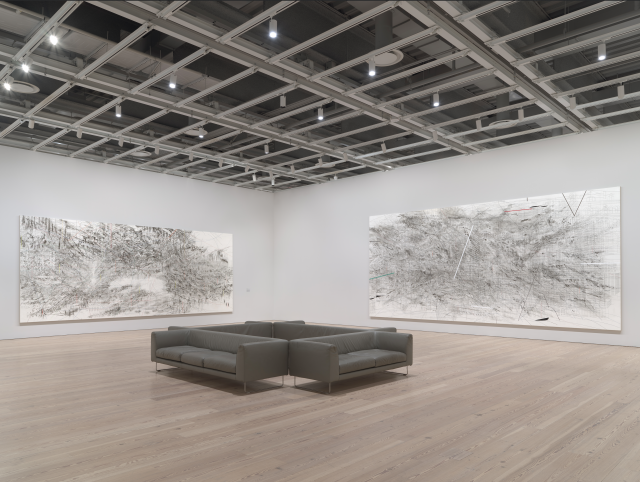
Installation view of “Julie Mehretu” at the Whitney, with Cairo, 2013, and Invisible Line (collective), 2010-11 (photo by Ron Amstutz)
As captivating as her works are from a distance, the exhibition rewards visitors who spend time with them at close range, their face as near as permissible to the smooth surfaces to take in every detail. “Few artistic encounters are more thrilling than standing close to one of her large canvases, enveloped in its fullness, color, forms, and symbolic content,” Whitney director Adam D. Weinberg writes in his catalog introduction. “One is easily swept up, into, and away by the works’ informational overload and force field of visually magnetic strokes, lines, routes, and trajectories. Viewers can, and do, lose their bearings in the attempt to read, comprehend, locate themselves, and make meaning from the confrontation.”
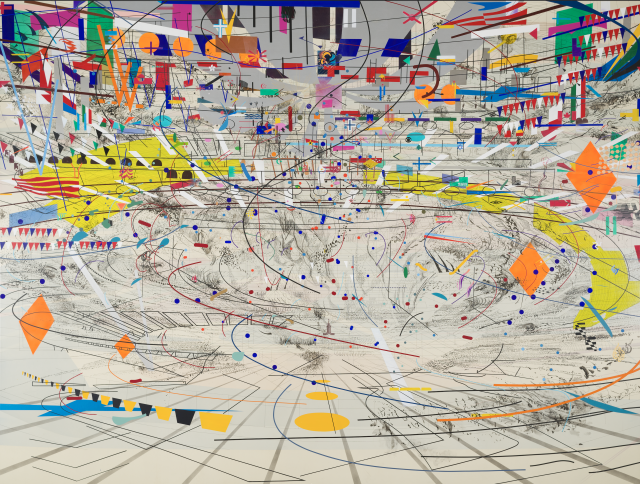
Julie Mehretu, Stadia II, ink and acrylic on canvas, 2004 (Carnegie Museum of Art, Pittsburg; gift of Jeanne Greenberg Rohatyn and Nicolas Rohatyn and A. W. Mellon Acquisition Endowment Fund 2004.50 / photo courtesy the Carnegie Museum, © Julie Mehretu)
Such ink-on-acrylic canvases as Conjured Parts (eye), Ferguson, Haka (and Riot), (A Painting in Four Parts) Part 1, Transcending: The New International, and Retopistics: A Renegade Excavation are prime examples of the virtuosity of her technique, from her delicate brushwork to her attention to the smallest of elements, as she explores such issues as migration, colonialism, white supremacy, and racial injustice. Meanwhile, ink-on-paper drawings such as her “Inkcity” series delve into the psychology behind her vision. “I was really interested in mining myself and who I was and what made me,” Mehretu says in a Whitney video. “My interest is not in trying to dictate or determine or explain or try to give any information to anyone in that way. There aren’t any directives or any proposals in these paintings. These paintings are really experiential paintings that are informed by the time, by me, by this moment, by trying to digest that.”
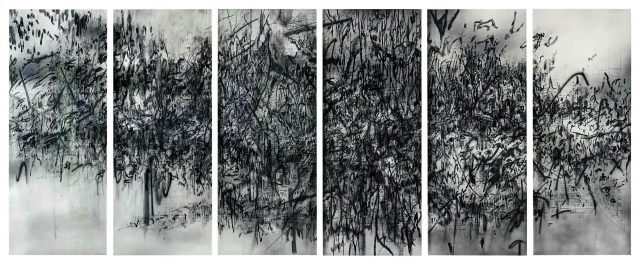
Julie Mehretu, Epigraph, Damascus, photogravure, sugar lift aquatint, spit bite aquatint, and open bite on six panels, 2016 (Los Angeles County Museum of Art, gift of Kelvin and Hana Davis through the 2018 Collectors Committee M.2018.188a–f, printed by BORCH Editions, Copenhagen, © Julie Mehretu)
The centerpiece is Ghosthymn (after the Raft), a large-scale canvas that has its own space opposite a window looking out at the Hudson River, David Hammons’s Day’s End, and the recently opened pier park known as Little Island. Created specifically for the Whitney show, the work references Théodore Géricault’s Raft of the Medusa as well as New York City’s past. “The insistence on new work and the idea of how that’s important . . . there was this time of suspension with the pandemic,” Mehretu says in the video. “There’s a wall that faces the river, and I was really interested in that wall and the relationship to the river and the relationship to the exterior. As you look out — I look at it every day from my studio [in Chelsea] — you sense the nineteenth-century-ness of this city even though so much of the architecture has changed. The Hudson River is the reason the city exists. There’s a sensibility in different periods of life, of the history of the making of this place, and the kind of immigrant nature of this place.” From a distance, bursts of red, yellow, and green battle it out with ghostly whites, but up close you’re likely to be surprised by what Mehretu uses to create some of her smaller images.
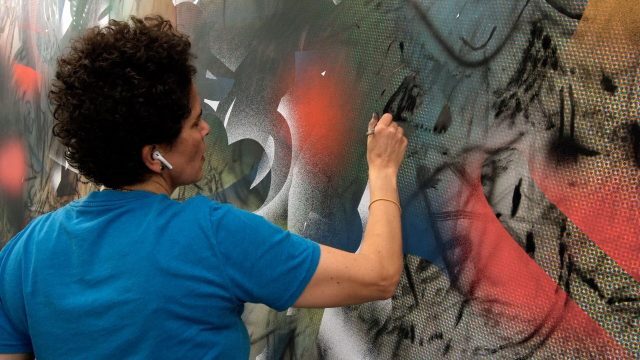
Julie Mehretu works on Haka (and Riot) in new documentary Julie Mehretu: Palimpsest (photo courtesy Checkerboard Film Foundation)
Mehretu was intimately involved with the survey, which began at LACMA before coming to New York City; she is extremely generous on the audio guide when talking about her process, a must-listen. You can also find out more when the museum premieres the documentary Julie Mehretu: Palimpsest from June 17 to 20, introduced by exhibition cocurator Rujeko Hockley and Checkerboard Film Foundation president Edgar Howard. And on June 24 at 7:00, Mehretu will be at the Whitney for a special in-person Pride celebration with DJ Reborn and refreshments, during which the ravishing exhibition will be open.